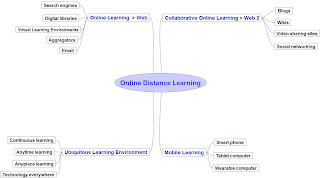Distance
education has been in existence for a long time and it will be around in the
foreseeable future. The earliest version of distance education, correspondence
education, developed in the mid nineteenth century in Europe and later spread
to the United States of
America
When I
enrolled for online studies with Walden
University
Before the
commencement of this course, my understanding of distance education was limited
to learning at a distance in an asynchronous learning environment. Although I
have always appreciated the benefits of online distance learning in terms of
the fact that access to learning is no longer
restricted by time and place because e-learning facilitates “on demand-learning
access” (Moller, Foshay and Huett, 2008, p. 70), my appreciation of distance learning was further enhanced as
the first week of this course draws to a close.
I have learned new concepts
about distance learning including the following: the need to focus on open learning because open learning offers great
potential for effective learning and “lifelong learning” (Mocker & Spear,
1982); open learning is learner-centered and helps to remove barriers to learning
that are inherent in conventional education settings (Lewis, 1986); technology
supported open learning provides an environment where learners can learn at
their own pace, collaborate freely and learn by trial and error (Khan, 2011); distance education is expected to
change significantly in future, however, it will not replace formal education
but will become “incorporated into most learning environments” (Simonson, n.d.)
What I
learned this week has influenced my personal definition of distance education. My revised
definition of distance education now includes my previous thoughts and new
information that I have since acquired. Distance learning is technology
supported open learning that provides flexible learning opportunities for
learners to learn at their own pace at the same time collaborating freely in
either an institution-based or non-institution-based learning environment.
 |
| My mindmap |
My vision
for the future of distance learning as it continues to evolve in harmony with
advancements in technology is particularly profound. Mobile computing has
already taken education by storm because it allows learners to learn whilst in
transit. Ubiquitous computing, a term coined by Xerox researcher Mark Weiser in
1980, is the next hype in education. The presence of technology will become not
only more omnipresent and pervasive but also less conspicuous as it seamlessly blends into our everyday lives (Jones
and Jo, 2004). Ubiquitous
computing provides an environment where anyone can learn continuously at
anyplace, anytime (Yahya, Ahmad & Jalil, 2010). Distance education has evolved to encompass not only e-learning but also
mobile learning, and is progressing towards encompassing ubiquitous learning.
References
CDLP California
Jones, V. & Jo, J.H. (2004). Ubiquitous
learning environment: An adaptive teaching
system using ubiquitous technology. In R.
Atkinson, C. McBeath, D. Jonas-Dwyer & R. Phillips (Eds), Beyond the
comfort zone: Proceedings of the 21st ASCILITE Conference (pp. 468-474. Perth
Khan, S. (2011). Salman Khan talk at TED
2011. Video. Retrieved from
Lewis, R. (1986). What is open
learning? Open Learning: The Journal of Open, Distance and e-Learning. 1(2).
Mocker, D. W. & Spear, G. E. (1982).
Lifelong learning: formal, nonformal, informal, and self-directed. ERIC.
Retrieved from
Moller,
L., Foshay, W., & Huett, J. (2008). The evolution of distance education:
Implications for instructional design on the potential of the web (Part 1:
Training and development). TechTrends, 52(3), 70–75. Retrieved from Academic
Search Complete
Nasseh, B.
( 1997). A brief history of distance education. Retrieved from
Simonson, M. (Walden
University
Sumner, J. (2000). Serving the system: a critical history of
distance education. Open Learning, 15(3). Retrieved from http://pages.towson.edu/bsadera/istc717/modules05/module8/3888263.pdf
Yahya, S., Ahmad, E.A. & Jalil, K.A. (2010). The definition and characteristics of ubiquitous learning: A
discussion. International Journal of Education and Development using Information and
Communication Technology, 6(1). Retrieved from: Education Research Complete.
Sidindih,
ReplyDeleteI really enjoyed the information on distance education. The complete blog page was well formated. I look forward to additional post.
Thanks for your comments. I am glad to learn that you enjoyed reading the post.
DeleteThe awfully revealing is! The author has conferred about a significant subject. I believe this is very useful, more informative nice learning article, arrangement. The writer has given some helpful information. This is the interesting job which I get here to be highly exciting. I would like to get more item from this worldwide platform. Thank you so much for this. Keep posting such good stuff.
ReplyDeleteOur Distance Education
I touch really precise version these articles I stingy there are writers that can create moral stuff.
ReplyDeleteOnline Distance Learning